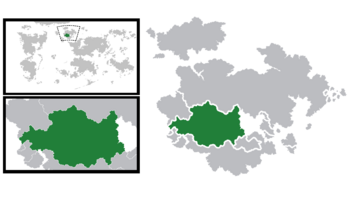Rousein
Jarldom of Rousein Jarldømmé de Rousein | |
|---|---|
| Motto: Vur Rousein, vilje donnegi ma Liv! For Rousein, I'll give my life! | |
| Anthem: Ma Patrielan | |
 Rousein on Saurth | |
 Rousein within Noraugalwyn | |
| Location | Noraugalwyn |
| Capital | Milieugar |
| Official languages | Rouseinisch, Callaise |
| Recognised national languages | Alennic, Rouseinisch Sign Language |
| Ethnic groups | Rouseiner 88%, Callais Rouseiner 6%, Alenner (Mountain Native), Envyner, Galavarian, Taevetti, Lisennisan, other non-Rouseiner |
| Religion | Reformed Valhennic 80%, Old Valhennic 5%, Callais Astraism, Alennic Valdennic, Envynic Forcatic, no religion 10%, other |
| Demonym(s) | Rouseiner |
| Government | Unitary Parliamentary Semi-constitutional Monarchy |
• Jarl | Lottwir II Bonnami-Lannevai |
• Hermon-Regent (Prime Minister) | Karles Lecorri |
• Grand Herduc-Regent (Minister of Noble Interests, Representative of Nobility) | Steffenos Julle Bardenos Granxendre |
| Legislature | Rouseiner Parliament |
| Occistag (meaning Western Parliamentary Building) | |
| Orienstag (meaning Eastern Parliamentary Building) | |
| Establishment | |
• the Great Flight, Formation of the Kingdom of Nou-Roieunséne | 764 |
• Division into three de facto independent states | 13th century |
• Formation of the Jarldom of Rousein after the Great Patriotic War | 18th century |
• Density | 130/km2 (336.7/sq mi) |
| HDI | 0.9 very high |
| Currency | Rouseiner crown |
| Driving side | right |
| Calling code | +33 |
| Internet TLD | .rs |
Rousein, formally the Jarldom of Rousein, is a semi-constitutional monarchy located in the North of Saurth on the continent of "Noraugalwyn" (rouseiner expression) bordering Envyn, Galavaria and Taevetti Confederation. Capital city of Rousein is Milieugar. Rouseiners are quite religious and predominantly Reformed Valhennic with conservative views on gender identity and controversial views on rights of women.
Early History
Callais Origins (≈ 500 BC - 764 AD)
500 BCE: Non-Callais Raunzhen tribe in today's northern coast of Callais
Known Raunzhen Chieftains:
Samunni (?300 BCE?)
Remilun (?50 CE?)
Belliced (631 - 658?)
Ceduni the Brave (672? - 698? CE) Last Known Raunzhen Chieftain
700 CE: Callais wipes out the original Raunzhen tribe, beggining of the Duchy of Roieunséne under early Callais Monarchy
Dukes of Roieunséne:
Alain the Knight (?701 - 710) Alain was given the dukeship of Roieunséne for his contribution in the invasion of Raunzhen tribe.
704 CE: Duke Alain becomes the king's marshal
710 CE: Duke Alain dies in the battle of Lavigne
Charlon the Seaman (710 - 742) Fascinated by the sea, he began the mass construction of longships, inspired by the original Raunzhen tribe that built them since fourth century BC. Charlon's voyage sailed all the way into today's Galavaria and raided local settlements while being there.
714 CE: Beginning of longship mass construction inspired by Rauzhen longship tradition
722 CE: Duke Charlon's northern voyage, first contant with Galavaria
725 CE: Raiding of galavarian coastal settlements
731 CE: Boom of Roieunséne's slave market
Galtier the Colonizer (742 - 764) He continued sailing efforts and established first permanent colonial settlements in the Northern continent. Duchy of Roieunséne thrived from raiding local natives and was getting insanely rich from the slave market. But the king of Callais wanted to tax Roieunséne's spoils, which escelated into a conflict. Galtier tried to hire mercenaries and even made slaves fight, but he still just couldn't match the strengh and size of king's army. So he flew with his subjects on approximately 140 crowded longships with approximately 15 500 people on them to the Northern continent, approximately 500 people didn't survive. Which marks the end of Callais origins.
743 CE: Establishment of first permanent colony in the Northern continent
755 CE: Even more colonies by 755
760 CE: Robust 10 meters tall statue of Duke Galtier is built by slaves, which head and torso is preserved and displayed in Callais museum
761 CE: War with Callais
763 CE: Southern part of the duchy is occupied by the king
764 CE: The Great Flight - 140 crowded longships with approximately 15 000 people on them successfully escape to the Northern continent


